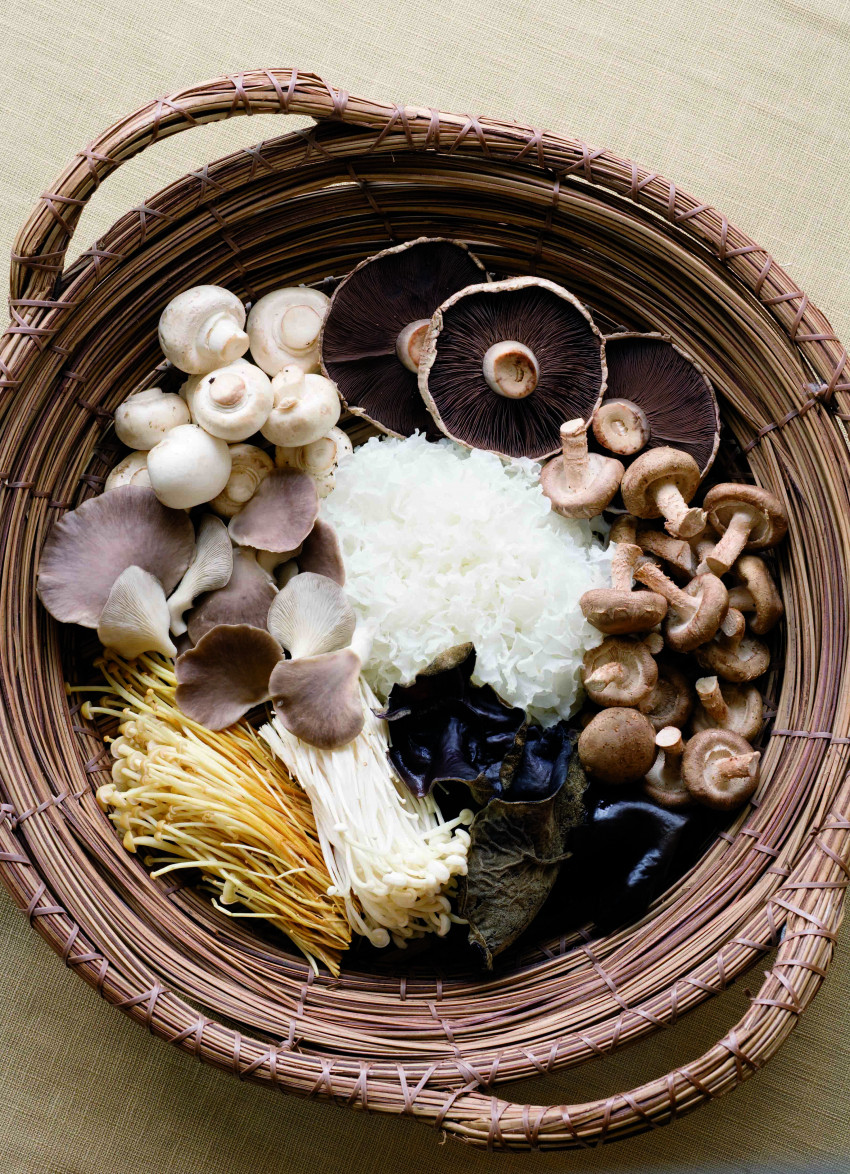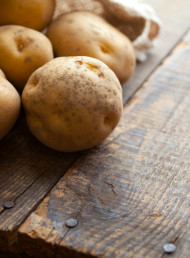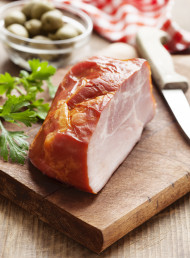Ways with: mushrooms
Photography by Aaron McLean.

Mushrooms offer a world of flavours and varieties as Food Editor, Claire Aldous, explains…
Shopping for mushrooms in New Zealand ten years ago you would have had the grand choice of white buttons or the larger, flat mushrooms. Only those lucky enough to have access to paddocks in autumn could add field mushrooms to their menu. (Unfortunately with the spreading of suburbia, the true field mushroom is today becoming a distant memory for most of us). Dried shiitakes could be found in Asian food stores, but only in the bigger cities.
How times have changed – the cultivation of exotic mushrooms for the local market has opened up a whole new world of flavours, not only for restaurants, but also for the domestic cook. Greengrocers, food stores and supermarkets now stock fresh shiitakes, phoenix or oyster mushrooms, gold and white enoki, wood ear and honeycomb along with the white buttons, Swiss browns and large flats. The ever-growing farmers’ markets are also great places to buy fresh mushrooms.
Gourmet food stores provide a selection of marinated and pickled mushrooms to add to an antipasti platter, and dried porcini can be purchased to give an amazing depth of flavour to dishes ranging from beef and duck braises to a tomato sauce served over hot fettuccine.
Artisan producer Noel Crawford of Aromatics in Hawke’s Bay produces delicious wine barrel-smoked mushrooms and a selection of sauces including a Mushroom Essence – an intensely flavoured reduction to add sparingly to risottos and casseroles.
The rapid growth of Asian markets ensures a range of dried mushrooms are standard shopping basket items to be used in everyday cooking.
Another member of the edible fungi family, fresh truffles are still in their infancy in New Zealand, but there is a passionate, dedicated group of growers determined to produce a high quality black truffle for the local market and, eventually, for the out of season northern hemisphere markets.
Saffron milk cap mushrooms and Japanese shoro are being grown with some success and there has been experimentation with porcini and matsutake. A range of issues such as de-forestation, the weather and the increased numbers of foragers has led to a marked decline in the harvesting of black and winter truffles in France, making the cultivation of truffles in New Zealand a very attractive proposition. Chefs here also have access to snap-frozen porcini, chanterelle and morels from France*.
Mushrooms are a source of fibre, potassium and protein and provide a number of vitamins, especially in the ‘B’ family, with B12 being the most important, especially for those who don’t eat meat. They are a good source of niacin, are low in calories and carbohydrates and have almost no fats.
When purchasing, look for mushrooms that are unblemished with no dark patches, and avoid any which are shrivelled or damp. Store in a paper bag in the refrigerator for 3-4 days. Don’t cover them with plastic wrap as this causes condensation and they’ll spoil rapidly. Remove any dirt with a soft brush or a damp cloth and only peel if necessary.
Varieties:
White button – round and plump with a mild flavour.
Marinate whole baby buttons in a vinaigrette of red wine vinegar, Dijon mustard and garlic. Leave for a few hours to soften and absorb the flavours.
Large flats or Portobello – fully matured mushrooms with a richer flavour and meaty texture. Great to use instead of a meat pattie in hamburgers.
Brush with oil mixed with finely chopped herbs and garlic, season and cook on the barbecue. Top with a piece of gorgonzola.
Shiitake – brown to dark gold in colour with a lovely, earthy taste and meaty texture when cooked. The stems tend to be tough even after cooking, so trim them off.
Thread onto metal skewers with red onion, red capsicum, cubed lamb or chicken and bay leaves. Brush the skewers with an oregano-flavoured marinade then grill on the barbecue. Shiitakes are great in a tempura batter and sprinkled with Shichimi – Japanese 7 spice chilli powder.
Phoenix or oyster – fan-shaped mushrooms which range in colour from cream through greyish-taupe. Delicate in flavour, use them in soups, stir-fries and salads. Gently rip them when adding to a recipe.
Gold and white enoki – slender, like a bean sprout, with a tiny cap. Trim off the spongy base and separate if the bunches are large. These make a great addition to a salad and are best very lightly cooked.
Wood ear – large and brown, they look like an elephant’s ears. Shiny on one side and velvety on the other. Unlike other mushrooms these should look damp. Not very much flavour but used more for texture in dishes. Add at the last minute to soups, stir-fries and Chinese-style pickled salads.
Honeycomb – looks like a large, textured sponge or overblown flower. The honeycomb is highly prized for its medicinal properties. Add to soups, stir-fried dishes and Asian braises. It can also be served as a dessert – simmered in a light syrup.
Saffron milk caps – pale orange with darker orange patches. These release a bright saffron coloured sap when cut and have a nutty, peppery taste. They retain their crunchy texture even after long cooking.
Japanese Shoro – cream in colour and highly valued in Japan for their texture.
Matsutake – creamy white to light brown with a meaty texture, strong aroma and flavour. The smaller matsutake are preferred, as the larger they get the more intense the flavour, which can be overwhelming. The Japanese use them in sukiyaki, tempura, soup and rice dishes.
Porcini/cepes – look like a very large button mushroom with a swollen stem and reddish brown colour. Regarded as the tastiest of the wild mushrooms, these are best eaten simply prepared; in a risotto or brushed with oil/lemon, grilled and topped with chopped garlic and parsley.
Chanterelles/girolles – these range from bright yellow to orange and are shaped like a curved trumpet. Delicious flavour and firm texture.
Morels – a dark brown, conical-shaped mushroom with a honeycomb surface. A rich flavour. These need careful cleaning when fresh, as the honeycomb traps dirt and sand.
latest issue:
Issue #120
As the days become shorter, and the nights cooler, the latest issue is perfectly timed to deliver delicious autumn dishes. From recipes using fresh seasonal produce such as feijoas and apples, to spectacular soothing soups and super-quick after-work meals in our Food Fast section, we’ve got you covered. With Easter on the horizon, we feature recipes that will see you through breakfast, lunch and dinner over a leisurely weekend holiday, and whip up chocolatey baking treats sure to please. We round up delicious dinners for two and showcase a hot new Korean cookbook before heading south to Dunedin to check out all that’s new in food and dining.The latest issue of dish is on sale NOW at all good bookstores and supermarkets – don’t miss it!





